Bundle theory argues that objects are merely collections of properties rather than substances with an underlying essence. This perspective challenges traditional views by asserting that what we perceive as a singular object is actually a composite of qualities such as color, shape, and texture. Explore the article to understand how this theory reshapes your understanding of identity and existence.
Table of Comparison
| Aspect | Bundle Theory | Narrative Identity |
|---|---|---|
| Core Idea | Self is a collection of perceptions and experiences. | Self is constructed through a coherent life story. |
| Main Proponent | David Hume | Paul Ricoeur, Marya Schechtman |
| View on Personal Identity | Fleeting and fragmented; no fixed self. | Continuous and unified through narrative. |
| Philosophical Focus | Perceptions and mental states. | Coherence and meaning in self-narratives. |
| Criticism | Lacks account of self-continuity over time. | Relies on subjective interpretation, may be less empirical. |
Introduction to Personal Identity
Bundle theory posits that personal identity consists of a collection of interconnected experiences and perceptions without an underlying self, emphasizing the fluid and composite nature of identity. Narrative identity, in contrast, frames personal identity as a coherent story constructed over time, integrating past events and future goals to form a unified sense of self. Key debates in the philosophy of personal identity revolve around whether identity is best understood through discrete experiential bundles or through continuous, self-authored narratives.
Defining Bundle Theory
Bundle theory, primarily associated with philosopher David Hume, defines personal identity as a collection of related but distinct perceptions without a fixed self or substance underlying them. This theory rejects the notion of a continuous, singular identity and instead views the self as a dynamic aggregation of changing experiences and sensations. By contrast, narrative identity emphasizes the construction of a coherent self through stories and temporal continuity, highlighting differing approaches to understanding personal identity.
Understanding Narrative Identity
Narrative identity is a psychological framework that explains how individuals construct a coherent self by integrating life events into an internalized, evolving story. Unlike bundle theory, which views the self as a mere collection of disconnected experiences without intrinsic unity, narrative identity emphasizes continuity and meaning over time through personal storytelling. This approach highlights the role of memory, interpretation, and cultural context in shaping a unified sense of self.
Historical Origins of Both Theories
Bundle theory, originating from David Hume in the 18th century, posits that the self is a collection of distinct perceptions without a unified core, emphasizing empirical skepticism in personal identity. Narrative identity, influenced by Paul Ricoeur and extended by contemporary philosophers, emerges from 20th-century hermeneutics and psychology, framing the self as a coherent story constructed over time. These contrasting origins highlight bundle theory's empiricist roots versus narrative identity's foundation in literary and phenomenological traditions.
Key Philosophers and Influencers
David Hume is a key philosopher of Bundle Theory, which posits the self as a collection of perceptions without intrinsic unity. Derek Parfit further develops this view by arguing that personal identity is not what matters, emphasizing psychological continuity and connectedness. In contrast, Paul Ricoeur plays a significant role in Narrative Identity, suggesting identity is constructed through the stories individuals tell about their lives, integrating time and experience into a coherent whole.
Core Differences Between Bundle Theory and Narrative Identity
Bundle theory posits the self as a collection of interconnected but discrete experiences and perceptions without a unifying essence, emphasizing the absence of an inherent, continuous identity. Narrative identity, in contrast, asserts that the self is constructed through a coherent and continuous life story, integrating past, present, and future events into a meaningful whole. The core difference lies in bundle theory's rejection of a unified self versus narrative identity's emphasis on the self as a structured, evolving story.
Strengths and Limitations of Bundle Theory
Bundle theory excels in explaining personal identity through a collection of interconnected experiences and mental states, allowing for a flexible and dynamic understanding of selfhood. Its strength lies in avoiding the need for a fixed, unchanging essence, accommodating changes over time without contradiction. However, its limitation is the challenge of accounting for a cohesive sense of continuity and unity, as it may reduce identity to a mere aggregation of disconnected events lacking an overarching narrative or core self.
Advantages and Critiques of Narrative Identity
Narrative identity offers the advantage of providing a cohesive and meaningful self-concept by integrating life experiences into a structured story, enhancing psychological coherence and personal growth. It allows for adaptability and change over time, reflecting how individuals make sense of evolving circumstances and social relationships. However, critiques highlight its potential to oversimplify complex identities by imposing linear narratives, risking exclusion of fragmented or contradictory aspects of the self emphasized in bundle theory.
Practical Implications for Self and Society
Bundle theory, emphasizing the self as a collection of loosely connected experiences, challenges traditional notions of personal responsibility and legal accountability. Narrative identity, which views the self as a coherent story, supports psychological well-being by fostering a sense of purpose and continuity, influencing therapeutic practices and social integration. Both theories impact societal frameworks, with bundle theory advocating for flexible identity recognition and narrative identity promoting social cohesion through shared cultural narratives.
Conclusion: Synthesizing Identity Frameworks
Bundle theory emphasizes identity as a collection of distinct experiences and perceptions without a singular, continuous self, while narrative identity frames the self as a coherent story integrating past, present, and future. Synthesizing these frameworks reveals that personal identity may be best understood as both a dynamic aggregation of mental states and an evolving autobiographical narrative. This integrated view acknowledges the fragmented nature of experience alongside the psychological need for coherent self-construction.
Bundle theory Infographic

 libterm.com
libterm.com